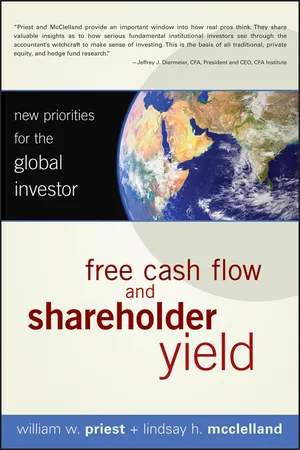Flow to Equity
Flow to equity refers to the cash flows available to a company's shareholders after all operating expenses, taxes, and debt payments have been made. It represents the residual income that remains for equity investors. This metric is important for investors and analysts as it helps assess the potential returns to shareholders and the company's ability to generate profits.
2 Key excerpts on "Flow to Equity"
- eBook - ePub
Investment Valuation
Tools and Techniques for Determining the Value of any Asset, University Edition
- Aswath Damodaran(Author)
- 2012(Publication Date)
- Wiley(Publisher)
...The calculation of FCFE is much more difficult in these cases because of the volatility induced by debt payments (or new issues), and the value of equity, which can a small slice of the total value of the firm for highly levered firms, is more sensitive to assumptions about growth and risk. It is worth noting, though, that in theory the two approaches should yield the same value for the equity. Getting them to agree in practice is an entirely different challenge and we will return to examine it later in this chapter. Problems There are three problems that we see with the free cash flow to the firm model. The first is that the free cash flows to equity are a much more intuitive measure of cash flows than cash flows to the firm. When asked to estimate cash flows, most of us look at cash flows after debt payments (free cash flows to equity), because we tend to think like business owners and consider interest payments and the repayment of debt as cash outflows. Furthermore, the free cash Flow to Equity is a real cash flow that can be traced and analyzed in a firm. The free cash flow to the firm is the answer to a hypothetical question: What would this firm's cash flow be if it had no debt (and associated payments)? The second is that its focus on predebt cash flows can sometimes blind us to real problems with survival. To illustrate, assume that a firm has free cash flows to the firm of $100 million but that its large debt load makes its free cash flows to equity equal to –$50 million. This firm will have to raise $50 million in new equity to survive, and if it cannot, all cash flows beyond this point are put in jeopardy. Using free cash flows to equity would have alerted you to this problem, but free cash flows to the firm are unlikely to reflect this. The final problem is that the use of a debt ratio in the cost of capital to incorporate the effect of leverage requires us to make implicit assumptions that might not be feasible or reasonable...
- eBook - ePub
Free Cash Flow and Shareholder Yield
New Priorities for the Global Investor
- William W. Priest, Lindsay H. McClelland(Authors)
- 2011(Publication Date)
- Wiley(Publisher)
...Accounting-related concepts such as earnings and P/E communicate little to an investor about the true profitability of the business, let alone a proper valuation for it. However, we can look to finance to provide superior insight into the true characteristics of an investment opportunity. This superior insight takes the form of free cash flow and its various applications. Today, there are myriad examples of the manner in which the investment community has adopted the finance-derived concept of free cash flow as the gold standard for capital allocations. It is the rare Wall Street research report these days that does not mention cash flow and the valuation metrics that incorporate it. In addition, leveraged buyout (LBO) firms and private equity (PE) funds focus almost exclusively on cash flow as the measure of value creation. Because so many of these LBO/PE acquisitions involve placing a great deal of debt on the target company’s books, the target company must be able to generate the cash flow necessary to service this new debt and to allow the acquirers to realize a profit. (Recall the example of Gibson Greeting Cards from earlier in the chapter.) For this reason, LBO and PE investors use a free cash flow model when evaluating takeover prospects. The success of this strategy is underscored when we consider that, in 2005, the net amount of capital raised by global private equity funds was $272 billion, nearly double the level from the prior year. 7 As of September 2006, this number increased to over $400 billion. In our view, this evidence of the growing popularity of private equity investing also indicates the heightened relevance of the cash flow metrics these funds are known to employ. There are also many recent books and articles that support the use of free cash flow benchmarks for both investors and managers...

